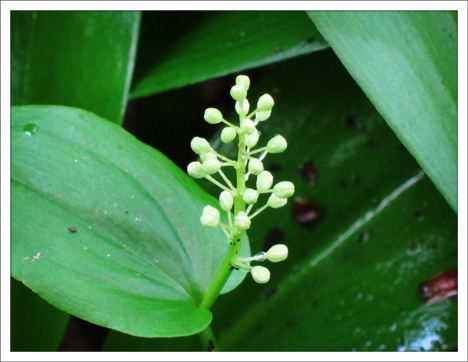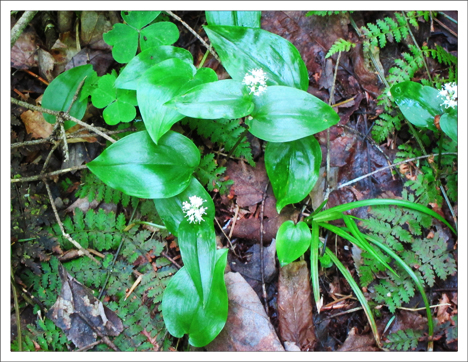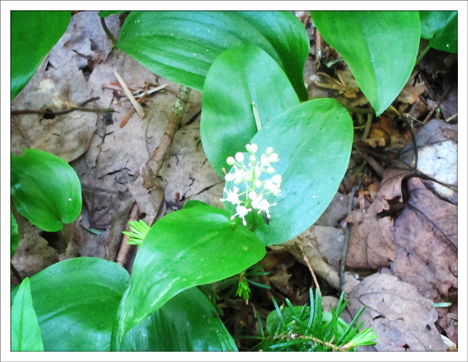Adirondack Wildflowers:
Canada Mayflower (Maianthemum canadense)
 Adirondack Wildflowers: Canada Mayflower in bud (23 May 2012)
Adirondack Wildflowers: Canada Mayflower in bud (23 May 2012)
| This page is no longer being updated. For an updated and expanded version of this material, see: Canada Mayflower (Maianthemum canadense). |
Canada Mayflower is an Adirondack wildflower which flourishes in woodlands. It is a member of the lily family. It has delicate, slightly zigzagging stems up to six inches tall, with one to three shiny, dark green leaves. The leaves are rounded and taper to sharply pointed tips. They have heart-shaped or broadly rounded bases that tend to clasp the stem.
The Latin name, Maianthemum, means May blossom - an appropriate name because the plant flowers in May. Canada Mayflower is also known as False lily-of-the-valley, two-leaved Solomon's seal, Canadian may-lily, and maïanthème du Canada.
Canada Mayflower is abundant in all types of dry to wet woods, even in dense shade from New Jersey west to Minnesota and north into Canada, and in forest remnants and parks. Canada Mayflower also grows in bogs and swamps throughout the north woods region.
 Adirondack Wildflowers: Canada Mayflower in bloom at the Paul Smiths VIC (30 May 2012)
Adirondack Wildflowers: Canada Mayflower in bloom at the Paul Smiths VIC (30 May 2012)
In mid-spring and early summer, Canada Mayflowers produce a cluster of tiny white flowers held in upright clusters on separate, delicate stems. Each flower is 1/4" wide and has four small, white, petal-like segments and four stamens. Plants with only one leaf are immature and will not flower until the second year.
The flowers become small, white berries with spots, later turning pale red later in the summer. The berries, which are about 1/8 inch wide, may be poisonous.
 Adirondack Wildflowers: Canada Mayflower in bloom (26 May 2012)
Adirondack Wildflowers: Canada Mayflower in bloom (26 May 2012)
Canada Mayflower may be seen at the Paul Smiths VIC along many of the trails. It usually begins blooming in May.
References:
- Lady Bird Johnson Wildflower Center. Native Plant Database.
- United States Department of Agriculture. Plants Database.
- Flora of North America. Plant Database.
- Ruth Schottman. Trailside Notes: A Naturalist's Companion to Adirondack Plants (Adirondack Mountain Club, 1998), pp. 38-42.
- Anne McGrath. Wildflowers of the Adirondacks (EarthWords, 2000), p. 10.
- Doug Ladd. North Woods Wildflowers (Falcon Publishing, 2001), p. 192.
- William K. Chapman, et al. Wildflowers of New York in Color (Syracuse University Press, 1998), pp. 4-5.
- Lawrence Newcomb. Newcomb's Wildflower Guide (Little Brown and Company, 1977), pp. 130-131.
